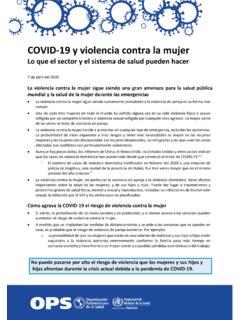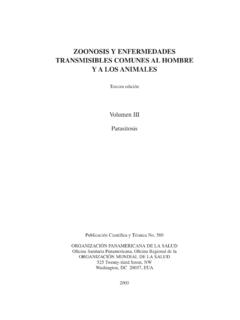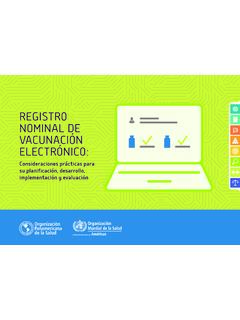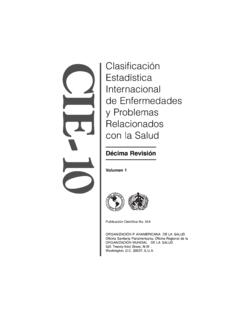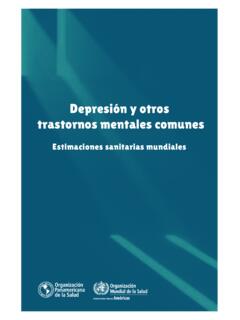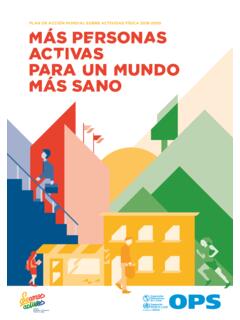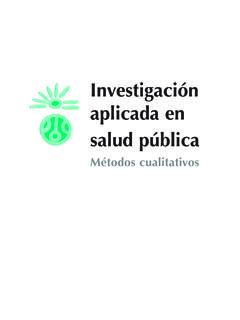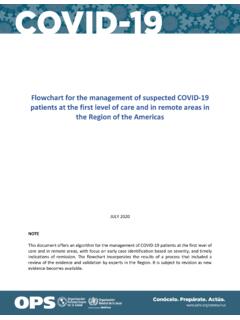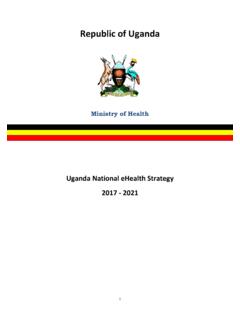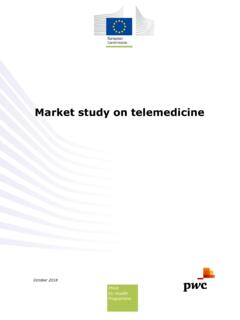Transcription of Framework for the Implementation of a Telemedicine Service
1 Framework for the Implementation of a Telemedicine ServiceFramework for the Implementation of a Telemedicine ServiceWashington, 20164 CPAHO HQ Library Cataloguing-in-PublicationAlso published in Spanish (2016):Marco de Implementaci n de un Servicio de TelemedicinaISBN 978-92-75-31903-1 Pan American Health for the Implementation of a Telemedicine Service . Washington, DC : PAHO, Telemedicine - standards. 2. Telemedicine trends. 3. Public Policy in Health. 4. Medical Informatics. 5. Patient-Centered Care. I. Title. ISBN 978-92-75-11903-7(NLM Classification: W 83) Pan American Health Organization, 2016. All rights Pan American Health Organization welcomes requests for permission to reproduce or translate its publications, in part or in full.
2 Applications and inquiries should be addressed to the Communications Department, Pan American Health Organization, Washington, , ( ). The Office of Knowledge Management, Bioethics and Research will be glad to provide the latest information on any changes made to the text, plans for new editions, and reprints and translations already of the Pan American Health Organization enjoy copyright protection in accordance with the provisions of Pro-tocol 2 of the Universal Copyright Convention. All rights are designations employed and the presentation of the material in this publication do not imply the expression of any opin-ion whatsoever on the part of the Secretariat of the Pan American Health Organization concerning the status of any country, territory, city or area or of its authorities, or concerning the delimitation of its frontiers or mention of specific companies or of certain manufacturers products does not imply that they are endorsed or recom-mended by the Pan American Health Organization in preference to others of a similar nature that are not mentioned.
3 Errors and omissions excepted, the names of proprietary products are distinguished by initial capital reasonable precautions have been taken by the Pan American Health Organization to verify the information contained in this publication. However, the published material is being distributed without warranty of any kind, either expressed or im-plied. The responsibility for the interpretation and use of the material lies with the reader. In no event shall the Pan American Health Organization be liable for damages arising from its and Layout: Andr s Venturino5 Table of Conceptual FrameworkComponentsTelemedicineTelemedic ine servicesTelemedicine application areasTelemedicine benefitsBarriers to Telemedicine implementationFactors facilitating Telemedicine developmentWHO and PAHO Telemedicine initiatives3.
4 Implementation Model of a Telemedicine ServiceIntroductionImplementation model of a Telemedicine serviceMultidimensional conceptWhy competitiveness?National settingRegional setting Institutional settingInterpreting competitiveness in the global knowledge economy Introducing the Telemedicine hat model 4. Strategic LevelContext analysisIdentifying needsIdentifying the necessary informationQuestions regarding final usersQuestions regarding Service delivery Questions regarding organizational issues Sources of informationAnalyzing the information to determine whether it meets expectationsInformation to include in the analysis of needsAnalysis of beliefs, perceptions, and attitudes about telemedicineEnsuring sustainability of the Telemedicine service5.
5 Organizational LevelThe organization during transformationsOrganizational aspects in Telemedicine servicesChange managementCreating a climate for changeParticipation of the organizationSupporting the Implementation of changes Establishing a coordination team781019293411121314141516172023232323 2324242630303031313131313232323535373737 373866. Public Policy LevelAnalysis of potential ICT advantages and disadvantages for health needsAnalyzing needs, resources, and organizational modelsPublic policy considerations7. Development of the Telemedicine ServiceLegal, regulatory, and security issuesTechnological and infrastructure issuesInteroperability issuesTechnological infrastructure issuesHuman resources issues Financial issues 8.
6 Follow-up, Evaluation, and Optimization LevelSupervising the operation of a Telemedicine serviceThe research questionCritical review of scientific literatureDesigning a research protocol to answer research questionsPatient-centered efficacy and effectivenessPatient satisfactionSpecial features to consider when designing studies to evaluate Telemedicine servicesExperimental studies Randomized clinical trial (RCT)Quasi-experimental studyObservational studiesCohort studies (or follow-up studies) Cross sectional studyQualitative studiesCost analysis and economic evaluation in telemedicineHow to design an economic evaluation in Telemedicine ?Evaluating the impact of Telemedicine on the organizationMeasures to evaluate the organizationDocumentary sources Useful evaluation models for implementationEvaluation of quality of Telemedicine servicesEvaluation of access to Telemedicine services Evaluation of acceptability of Telemedicine servicesEvaluation of the impact of Telemedicine costsEvaluation in the health care organizationComprehensive Framework for Telemedicine evaluation.
7 The MAST modelObjective of the MAST-based evaluation Model structure and evaluation domains Initial considerationsActual evaluation and outcome measuresEvaluation of transferability of resultsReferences39445067404042454646474 8485151525253545455555556565656575760606 16262626263636363646465667 AcknowledgementsThe Pan American Health Organization (PAHO/WHO) would like to thank collaborators -in particular, the Universitat Oberta de Catalunya-, reviewers, and consultants whose dedication,technical expertise, and support have made this first edition of the Framework for theImplementation of a Telemedicine Service , editing, and technical reviewSpecial thanks are due the author of this work, Francesc Saig Rubi (Universitat Oberta de Catalunya), and his collaborators: Joan Torrent Sellens, Ivan Soler Ramos, Cari Almaz n S ez, Anna Kotzeva, and Julio Villalobos Hidalgo.
8 We would also like to thank the reviewers who provided comments prior to the release of for this edition: Guillermo Bill, Walter Curioso Vilches, Luiz Ary Messina, and Adri n Pacheco-L staff: David Novillo-Ortiz and Marcelo D and Technical Review This publication was developed by the Department of Knowledge Management, Bioethics and Research (KBR), Pan American Health Organization (PAHO) within the frame-work of the PAHO ehealth is regarded as one of the major innovations in health services, not only from the technological but also from the cultural and social perspectives since it benefits accessibility to health care services and improves the quality of medical care and organizational efficiency.
9 Telemedicine has a role in providing solutions to the challenges posed by socioeconomic changes in health care systems in the 21st century (greater demands on health care, aging populations, increased mobility of citizens, the need to manage large amounts of information, global competitiveness, and improved health care provision), all in an environment of limited budgets and restrictions on spending. Nevertheless, there are significant barriers to standardizing Telemedicine and for its full consolidation and expansion. In spite of the strong political will to incorporate Information and Communication Technologies (ICTs) into health care and increased activity in relation to Telemedicine , in it continues to have little more than a token presence in clinical and health care Additionally, although an increasing number of pilot projects and viability studies are being carried out, only a few Telemedicine applications have been established in clinical practice and incorporated into medical processes, and even these have often been abandoned once the initial stage was over (1)(2).
10 This document aims to provide solutions for the successful Implementation of Telemedicine ser-vices (and ehealth , in general) in the health care setting. Following a literature review that identifies key theories, models, and frameworks used in the science of Implementation , we introduce a theoretical Framework that addresses the obstacles to incorporating and standardizing the use of Telemedicine in health care institutions. This narrative review gathers qualitative information from different sources on a particular topic, and summarizes and synthesizes the literature in order to determine what is known about a topic (3). This theoretical Framework is based on understanding the context within its broader structure, together with existing challenges and opportunities.
